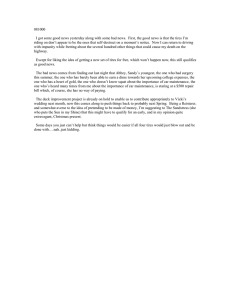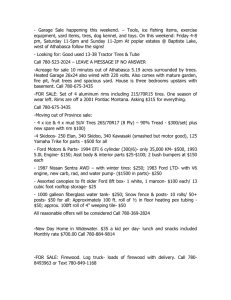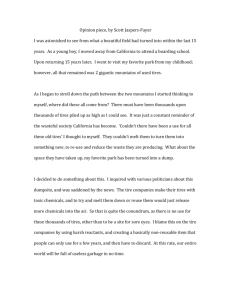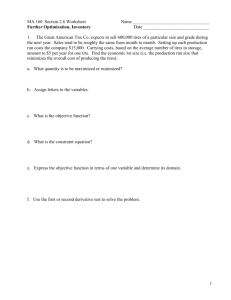Chapter 02.00F Physical Problem for Differentiation Industrial Engineering
advertisement
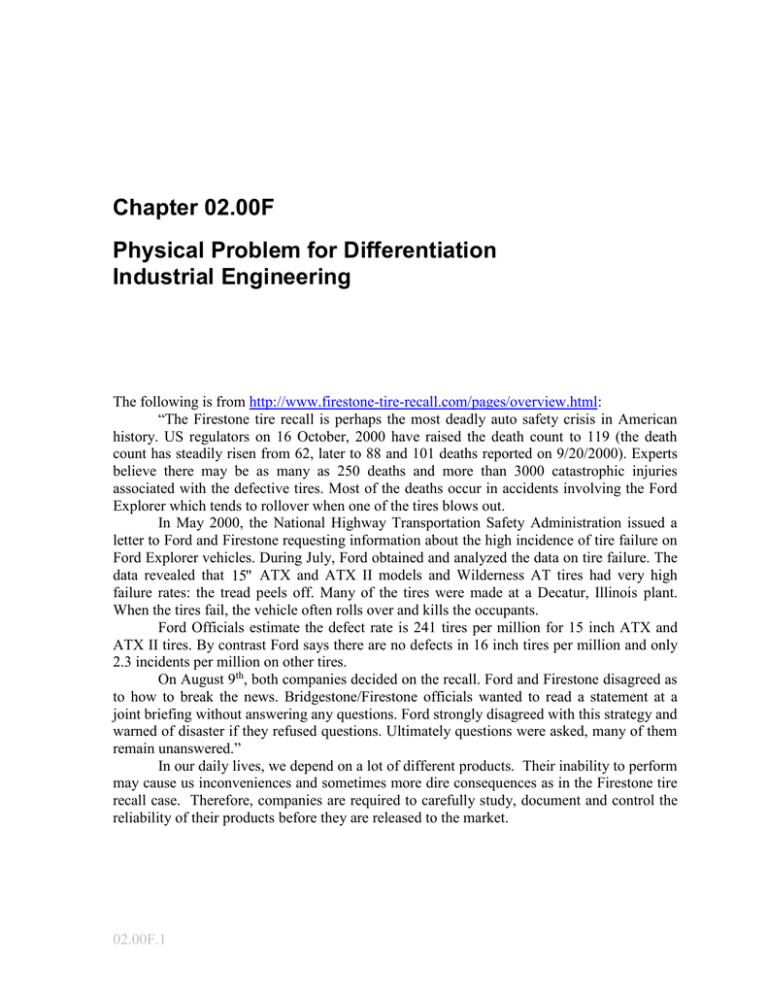
Chapter 02.00F Physical Problem for Differentiation Industrial Engineering The following is from http://www.firestone-tire-recall.com/pages/overview.html: “The Firestone tire recall is perhaps the most deadly auto safety crisis in American history. US regulators on 16 October, 2000 have raised the death count to 119 (the death count has steadily risen from 62, later to 88 and 101 deaths reported on 9/20/2000). Experts believe there may be as many as 250 deaths and more than 3000 catastrophic injuries associated with the defective tires. Most of the deaths occur in accidents involving the Ford Explorer which tends to rollover when one of the tires blows out. In May 2000, the National Highway Transportation Safety Administration issued a letter to Ford and Firestone requesting information about the high incidence of tire failure on Ford Explorer vehicles. During July, Ford obtained and analyzed the data on tire failure. The data revealed that 15" ATX and ATX II models and Wilderness AT tires had very high failure rates: the tread peels off. Many of the tires were made at a Decatur, Illinois plant. When the tires fail, the vehicle often rolls over and kills the occupants. Ford Officials estimate the defect rate is 241 tires per million for 15 inch ATX and ATX II tires. By contrast Ford says there are no defects in 16 inch tires per million and only 2.3 incidents per million on other tires. On August 9th, both companies decided on the recall. Ford and Firestone disagreed as to how to break the news. Bridgestone/Firestone officials wanted to read a statement at a joint briefing without answering any questions. Ford strongly disagreed with this strategy and warned of disaster if they refused questions. Ultimately questions were asked, many of them remain unanswered.” In our daily lives, we depend on a lot of different products. Their inability to perform may cause us inconveniences and sometimes more dire consequences as in the Firestone tire recall case. Therefore, companies are required to carefully study, document and control the reliability of their products before they are released to the market. 02.00F.1 02.00F.2 Chapter 02.00F Reliability Function Reliability function is frequently used to describe the probability of an item operating under certain conditions for a certain amount of time without failure. The reliability function is a function of time, in that every reliability value has an associated time value. In other words, one must specify a time value with the desired reliability value, that is, 95% reliability at 100 hours. Mathematically, the reliability function R (t ) is the probability that a system will be successfully operating without failure in the interval from t 0 to t , R(t ) P(T t ), t 0 f ( s )ds t where T is a random variable representing the failure time or time-to-failure and f (t ) is the time to failure distribution function. More often than not, the time to failure distribution function is denoted by exponential, Weibull, normal or lognormal distribution based on the characteristics of the underlying product or the system. However, for complex practical systems the above distributions may not provide an accurate fit for the time to failure distribution function. Also of interest is the failure distribution function F (t ) which describes the probability of an item failing before a certain period of time. As you may guess, the failure distribution function and the reliability function are related to each other by F (t ) R(t ) 1 where t F (t ) f ( s)ds 0, Failure Rate Function The failure rate function, or hazard function, is also very important in reliability analysis because it specifies the rate of the system aging. The failure rate function h(t ) is defined as: R(t ) R(t t ) h(t ) lim t 0 tR(t ) f (t ) R (t ) The importance of the failure rate function is that it indicates the changing rate in the aging behavior over the life of a population of components. For example, if the time to failure distribution function follows an exponential distribution with parameter , then the failure rate function is Physical Problem for Differentiation: Industrial Engineering h(t ) 02.00F.3 f (t ) R (t ) e t e t This means that the failure rate function of the exponential distribution is a constant. In this case, the system does not have any aging property. This assumption is usually valid for software systems. However, for hardware systems, the failure rate could have other shapes. More information regarding reliability analysis can be found in [1]. A series systems, shown in Figure 1, is defined as n independent components arranged in series. The reliability of the system at time t , Rs (t ) , is the probability that all components survive to time t , or in other words, n Rs (t ) R1 (t ) R2 (t )....Rn (t ) Ri (t ) i 1 R1 R2 ….. Rn Figure 1 Block diagram of a series system Problem Statement The following example relies on the research published in [2]. Low power portable direct methanol fuel cell (DMFC) systems provide higher energy density and longer operational life compared with Li-ion batteries widely used in portable electronic devices such as cellular phones, laptops, etc. DMFC systems consist of three main subsystems, namely the fuel cell stack, fuel tank and the Balance of Plant which are assumed to be independently connected to each other in series as shown in Figure 2. These systems are still an immature technology and there is no publicly available reliable failure data for DMFC components. Fuel Tank Balance of Plant Fuel Cell Stack Figure 2 Block diagram of a DFMC system Consider the following reliability data in Table 1 for the DMFC system. Table 1. Reliability of DFMC system 10 100 1000 2000 3000 4000 5000 t (hrs) 0 1 R (t ) 1 0.9999 0.9998 0.9980 0.9802 0.9609 0.9419 0.9233 0.9050 02.00F.2 Chapter 02.00F QUESTIONS Calculate the value of the failure rate function, h(t ) at t 10 hours. Calculate the value of the failure rate function, h(t ) at t 2000 hours. Calculate the value of the failure rate function, h(t ) at t 4000 hours. Compare the results you have in questions 1-3. What can be said about the failure rate function and the time to failure distribution function F (t ) of the DMFC system based on the data provided? 5. You are told that the estimated failure rate for the fuel tank and the fuel cell stack are constant with values 5.42 10 8 and 7.78 10 6 . Can you calculate an estimate the failure rate for the Balance of Plant? 6. If you are told that the time to failure distribution function of the DFMC system is exponential with parameter 1.21 10 5 , calculate the accuracy of your answers to questions 1-3. 1. 2. 3. 4. References [1] E. A. Elsayed (1996), Reliability Engineering, Addison-Wesley. [2] N.S. Sisworahardjo, M.S.Alam and G. Aydinli, “Reliability and availability of low power portable direct methanol fuel cells”, Journal of Power Sources, 177, 2008, p.412-418. Topic Sub Topic Summary Author Date Web Site Differentiation Physical Problem for Industrial Engineering Reliability of manufactured parts over time Ali Yalcin Nov 10th, 2008 http://numericalmethods.eng.usf.edu
